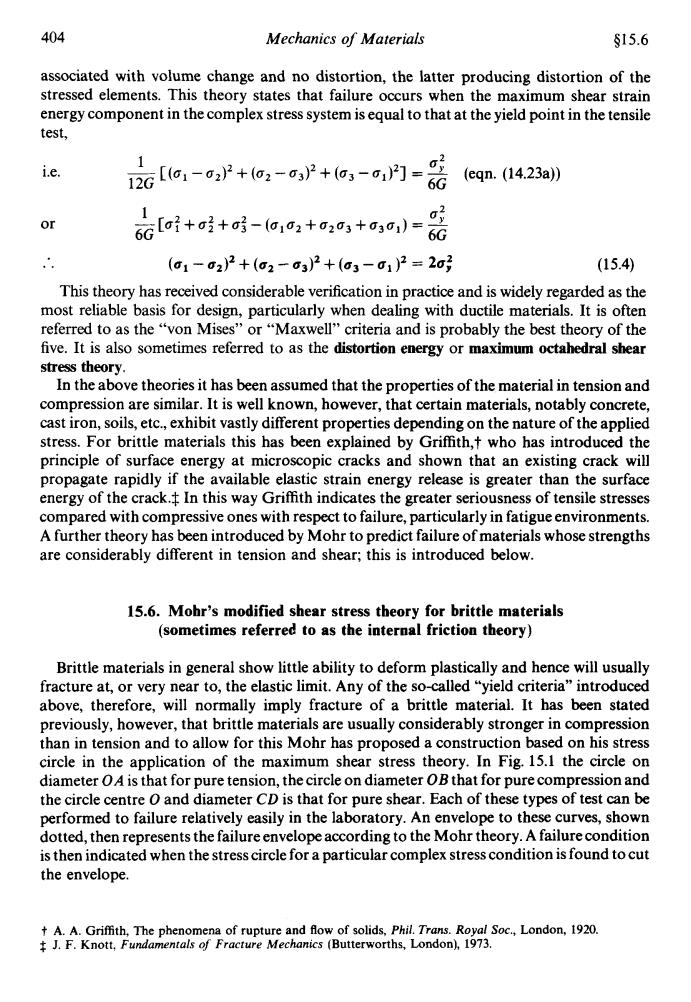正在加载图片...

404 Mechanics of Materials §15.6 associated with volume change and no distortion,the latter producing distortion of the stressed elements.This theory states that failure occurs when the maximum shear strain energy component in the complex stress system is equal to that at the yield point in the tensile test, i.e. 【oi-o+o,-,P+a,-a门-装 1 (eqn.(14.23a) or 6G[o+i+号-a12+20+3)=6记 (c1-0z)2+(c2-c32+(c3-1)2=2a3 (15.4) This theory has received considerable verification in practice and is widely regarded as the most reliable basis for design,particularly when dealing with ductile materials.It is often referred to as the "von Mises"'or "Maxwell"criteria and is probably the best theory of the five.It is also sometimes referred to as the distortion energy or maximum octahedral shear stress theory. In the above theories it has been assumed that the properties of the material in tension and compression are similar.It is well known,however,that certain materials,notably concrete, cast iron,soils,etc.,exhibit vastly different properties depending on the nature of the applied stress.For brittle materials this has been explained by Griffith,t who has introduced the principle of surface energy at microscopic cracks and shown that an existing crack will propagate rapidly if the available elastic strain energy release is greater than the surface energy of the crack.In this way Griffith indicates the greater seriousness of tensile stresses compared with compressive ones with respect to failure,particularly in fatigue environments. A further theory has been introduced by Mohr to predict failure of materials whose strengths are considerably different in tension and shear;this is introduced below. 15.6.Mohr's modified shear stress theory for brittle materials (sometimes referred to as the internal friction theory) Brittle materials in general show little ability to deform plastically and hence will usually fracture at,or very near to,the elastic limit.Any of the so-called "yield criteria"introduced above,therefore,will normally imply fracture of a brittle material.It has been stated previously,however,that brittle materials are usually considerably stronger in compression than in tension and to allow for this Mohr has proposed a construction based on his stress circle in the application of the maximum shear stress theory.In Fig.15.1 the circle on diameter OA is that for pure tension,the circle on diameter OB that for pure compression and the circle centre O and diameter CD is that for pure shear.Each of these types of test can be performed to failure relatively easily in the laboratory.An envelope to these curves,shown dotted,then represents the failure envelope according to the Mohr theory.A failure condition is then indicated when the stress circle for a particular complex stress condition is found to cut the envelope. t A.A.Griffith,The phenomena of rupture and flow of solids,Phil.Trans.Royal Soc.,London,1920. J.F.Knott,Fundamentals of Fracture Mechanics (Butterworths,London),1973.404 Mechanics of Materials $15.6 associated with volume change and no distortion, the latter producing distortion of the stressed elements. This theory states that failure occurs when the maximum shear strain energy component in the complex stress system is equal to that at the yield point in the tensile test, i.e. or 1 u2 - 6G c0: + 0: + 0: - (ala2 + 0203 + O3O1) = 2 6G .. (a1 - a2)2 + (a2 - up)? + (a3 - 61 )2 = 24 (15.4) This theory has received considerable verification in practice and is widely regarded as the most reliable basis for design, particularly when dealing with ductile materials. It is often referred to as the “von Mises” or “Maxwell” criteria and is probably the best theory of the five. It is also sometimes referred to as the distortion energy or maximum octahedral shear stress theory. In the above theories it has been assumed that the properties of the material in tension and compression are similar. It is well known, however, that certain materials, notably concrete, cast iron, soils, etc., exhibit vastly different properties depending on the nature of the applied stress. For brittle materials this has been explained by Griffith,? who has introduced the principle of surface energy at microscopic cracks and shown that an existing crack will propagate rapidly if the available elastic strain energy release is greater than the surface energy of the crack.$ In this way Griffith indicates the greater seriousness of tensile stresses compared with compressive ones with respect to failure, particularly in fatigue environments. A further theory has been introduced by Mohr to predict failure of materials whose strengths are considerably different in tension and shear; this is introduced below. 15.6. Mohr’s modified shear stress theory for brittle materials (sometimes referred to as the internal friction theory) Brittle materials in general show little ability to deform plastically and hence will usually fracture at, or very near to, the elastic limit. Any of the so-called “yield criteria” introduced above, therefore, will normally imply fracture of a brittle material. It has been stated previously, however, that brittle materials are usually considerably stronger in compression than in tension and to allow for this Mohr has proposed a construction based on his stress circle in the application of the maximum shear stress theory. In Fig. 15.1 the circle on diameter OA is that for pure tension, the circle on diameter OB that for pure compression and the circle centre 0 and diameter CD is that for pure shear. Each of these types of test can be performed to failure relatively easily in the laboratory. An envelope to these curves, shown dotted, then represents the failure envelope according to the Mohr theory. A failure condition is then indicated when the stress circle for a particular complex stress condition is found to cut the envelope. t A. A. Griffith, The phenomena of rupture and flow of solids, Phil. Trans. Royal SOC., London, 1920. $ J. F. Knott, Fundamentals of Fracture Mechanics (Butterworths, London), 1973